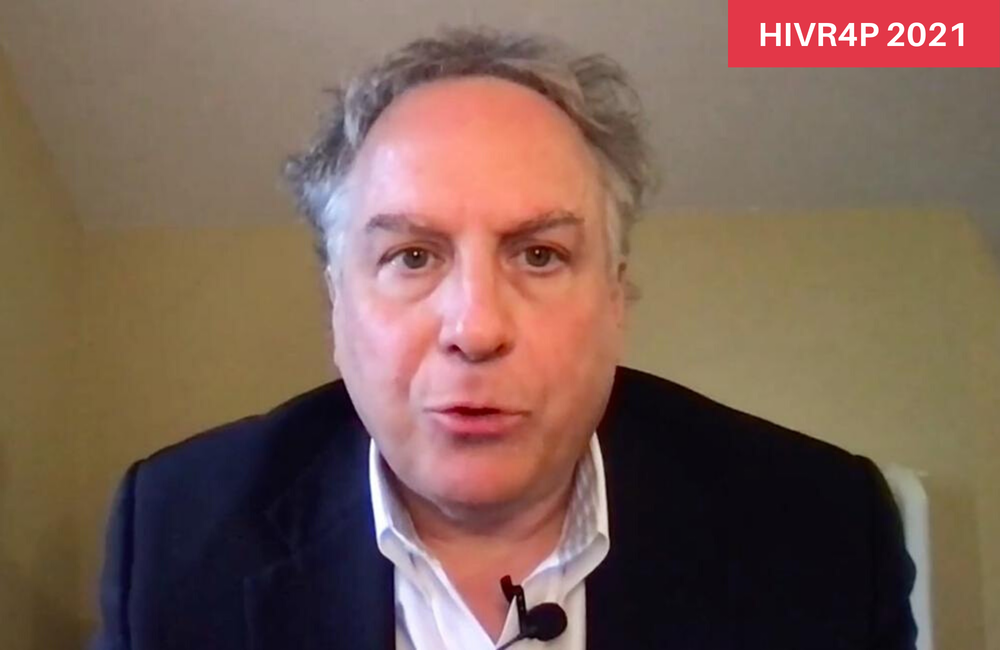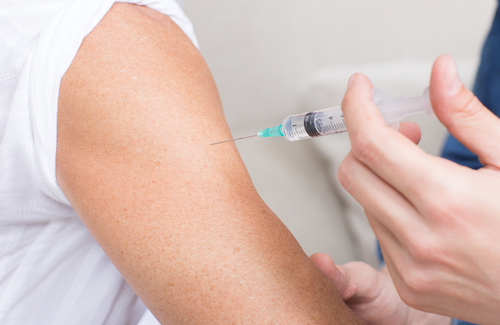
In the search for an HIV vaccine and for other immune-based therapies, the last 12 months have seen a major disappointment and a modest success. The disappointment came this time last year when the Uhambo/HVTN 072 vaccine trial was terminated due to lack of efficacy. The modest success came a year later when on 26 January it was announced that the AMP study, the first-ever efficacy trial of a so-called broadly neutralising antibody (bNAb), VRC01, produced a modest reduction in HIV infections, but a 75% reduction in the class of viruses most sensitive to it.
Dr Mark Feinberg, President and CEO of IAVI, the International AIDS Vaccine Initiative, found grounds for optimism in the field when he gave a plenary talk at the recent HIV Research for Prevention (HIVR4P) virtual conference two days after the AMP study results were announced.
“Quite clearly, we are getting closer to the goal of an effective immune therapy against HIV,” he said. “Though we still don’t know how long our journey will take.”
Slow progress to a vaccine
The Uhambo vaccine was only the fifth ever to be tested in a large phase III efficacy trial, in a history that goes back to 2003. Its failure was especially disappointing as it was based on what was hoped would be an improvement to the only HIV vaccine that has ever shown evidence of efficacy – the one used in the RV144 trial that finished in 2009. The reduction in HIV infections in people given the vaccine in that trial was only 28%; it was hoped the Uhambo vaccine would be more efficacious.
The protective effect seen in RV144, though weak, was ascribed to several unexpected responses. The first was that helpful antibodies were formed in response to areas of the HIV envelope protein called the V1 and V2 loops – not the V3 loop as predicted. The second was a favourable balance between two types of antibody called IgA and IgG – the more of the second, the better. And the third was that, in a feedback loop, the IgG antibodies then went on to re-stimulate activity by the oldest, least specific but fastest-acting part of the immune system, the innate immune system, which sent killer cells rapidly to sites of infection.
This immune response was only able to suppress the activity of the least virulent category of viruses – so-called ‘tier 1’ viruses. It was hoped that the apparently stronger immunogenicity results seen in pre-Uhambo trials would mean that it could deal with virus strains that were better at infecting cells. The reason Uhambo did not work, despite apparently stronger immunogenicity, may be because in the far higher-incidence milieu of southern Africa, the sheer number of exposures to genetically varied HIV viruses, many of them more virulent than tier 1 viruses, overwhelmed the relatively narrow immune response the vaccine generated.
There is currently a pair of studies, testing an HIV vaccine made by Johnson and Johnson, that aim to get round this problem by inoculating subjects with a much more varied ‘mosaic’ of different HIV epitopes from different viral strains (an epitope is the particular part of a foreign protein that induces a useful immune response).
Imbokodo/HVTN 705 gives a vaccine or placebo to 2600 women in five southern African countries and Mosaico/HVTN 706 to 3800 gay and bisexual men and transgender women in the US, three European and three Latin American countries. Imbokodo, after a slight slowdown due to COVID, is due to finish early next year. Mosaico was more badly affected by COVID and some Latin American sites have only just started, implying a finish in mid-2024, though obviously this might be influenced by results from Imbokodo.
Do we need a different kind of vaccine?
If these vaccines do not work, Feinberg said, it might imply that the fundamental hypothesis about the mechanism behind the efficacy of RV144 – assuming it was not just a fluke – might be incorrect.
Firstly, the ‘challenge’ model might be wrong. In the monkey studies that initially test the likely effect of vaccines, PrEP and microbicides, the interventions are tested by seeing if they stop infection in monkeys ‘challenged’ with a number of attempts to infect them, usually by rectal or vaginal inoculations with relatively low doses of a SHIV virus (an artificial human HIV virus re-engineered to make it infectious to monkeys).
Most monkey experiments involve 6-12 challenges. But people don’t just have sex six times and then stop, and may encounter genetically distinct HIV viruses each time they do, or at least every time they meet a new partner. And the low-dose model, designed to mimic the relatively inefficient process of HIV sexual transmission, may fail to capture the real magnitude of the assault HIV makes on the occasions it does infect. The Imbokodo vaccine had 67% efficacy against six challenges – but how much would it have against a year’s worth of them?
Secondly, it was a surprise that ordinary, non-neutralising antibodies appeared to have a role. While these protein molecules (which directly block viral replication and also tag viruses for destruction by other parts of the immune system) act as the mechanism behind other vaccines, it was assumed they had no efficacy in HIV – after all, the standard HIV test detects non-neutralising antibodies, which clearly have no effect against ongoing infection.
It was thought that any effect against HIV would only be demonstrated by the so-called broadly neutralising antibodies (bNAbs) – unusually shaped antibodies that only develop in a minority of people who have had chronic, untreated HIV infection.
The triumph of the AMP study was to show that such bNAbs, extracted from their donors, purified and then infused as a prevention drug – really did neutralise infectious HIV viruses, even if only the least virulent ones.
Reverse engineering vaccines and training germ cells
Antibodies arise in response to epitopes: bNAbs to ‘conserved’ epitopes, often well-concealed or fleetingly visible parts of the virus it can’t afford to modify without losing function. The next approach to designing a vaccine, Weinberg said, would be to employ so-called Rational Vaccine Design.
This reverse-engineers vaccines by discovering bNAbs in people and then exploring their structure so it can be mapped back onto the specific epitope on HIV that it must have risen in response to. A vaccine can then be designed using that epitope, to see if it can jump-start the production of bNAbs. While these normally arise only during chronic HIV infection, they should, if induced in HIV-negative people with a vaccine, be able to stop new infections. Repeating this process, Weinberg showed, could result in a vaccine containing multiple epitopes.
“An effective HIV vaccine should consistently induce bNAbs against multiple different epitopes,” Feinberg said. These should be able to generate various bNAbs that attach to multiple sites on the HIV envelope spikes and so block infection much more completely.
He added cautiously: “We now have much more understanding of how high the genetic barrier is we have to scale to block infection, and some interesting data that suggest we are at least on the beginning of the path to accomplish that goal”.
Another approach is so-called 'germline targeting'. In this, sequential vaccines are targeted at the B-cells of the immune system that produce antibodies, 'training' their response until they generate bNAbs of their own accord. As this might take multiple vaccinations, it is currently more of a research tool than one generating candidate vaccines. Nonetheless IAVI G001, the first phase I trial using a modified HIV envelope protein to perform this feat, finishes next month.
The problem with germline-targeting vaccines is that they tend to degrade chemically; IAVI C101, which uses a chemically stabilised version of the HIV envelope protein called BG505 SOSIP, is a phase II trial that finishes in mid-2022.
This report from aidsmap.com, from last year's CROI, discusses the challenges and possibilities of this approach.
One problem with vaccine development is that pre-clinical trials in animals often give results that poorly predict what eventually happens in humans. In animal studies of BG505 SOSIP, when it was given to mice, no neutralising antibodies were produced; when given to rabbits or guinea pigs, strong but overly specific antibodies; and when given to monkeys, broad but weak ones. The only animals that produced broad and potent ones were cows, whose immune systems are the least human-like of any on this list.
Nonetheless, two more studies of the BG505 SOSIP protein are going forward, one to find the best dose and the other to look at adjuvants – accompanying substances that provoke a strong immune response.
Onward from AMP: passive immunisation with broadly neutralising antibodies
Broadly neutralising antibodies can be used as ‘passive immunisation’ too. This means giving them in an infusion, essentially as drugs. From AMP we have proof of concept, and the pipeline of studies of bNAbs as prevention is quite full.
Although VRC01 could neutralise 85% of HIV viral isolates in a lab, it clearly didn’t do this in practice. This may be because you need a relatively large dose; its IC50 – the dose needed to inhibit HIV replication by 50% – is about 300 nanograms per millilitre ng/ml. There are some bNAbs whose IC50 is as little as 2ng/ml. However, the most potent ones also tend to be the most specific, with activity against a narrower selection of viral isolates.
The way forward is to combine bNAbs. The US National Institutes of Health are studying several combinations with IC50s of 20-30 ng/ml which are active in the lab dish against 95% of isolates while the Aaron Diamond AIDS Research Centre in New York has one combination, using two antibodies called 10E8 and P140, with an IC50 of around 5 ng/ml, that is active against 100% of isolates in the lab dish so far.
The level of antibodies needed to truly neutralise most isolates of HIV (to completely annul its viability) is over a thousandfold higher, in microgams per millilitre (mcg/ml). If VRC01 was used by itself at a concentration of 30mcg/ml (30,000 ng/ml) it would only neutralise 47% of a panel of HIV viral variants. But if combined with two other antibodies, PGDM 1400 and PGT 121, it would neutralise 94% of variants.
Will the world pay for HIV vaccines and antibody-based drugs? Lessons from COVID-19
This is quite a strong concentration of antibodies, and although monoclonal antibodies (ones grown artificially) now form the latest generation of drugs against cancer and other conditions, they are more expensive to develop and produce than small-molecule drugs.
In the case of an infectious disease like HIV that is concentrated in lower-income countries, Feinberg said, quoting from an IAVI statement, “The business and partnership models that have vastly expanded global access to some HIV drugs are not necessarily applicable or sufficient”.
He ended however on a positive note by emphasising how the rush to develop a COVID-19 vaccine had lessons for the field in general.
Firstly, it had required innovative, abbreviated trial designs, such as iterative design (constantly feeding back results from small trials to redesign candidate vaccines), and conducting careful safety testing in preclinical models that did away with the necessity of some or all animal testing.
Secondly, it had proved the applicability of novel vaccines such as RNA-based ones, which were also quickly adaptable, so they could be altered to deal with different viral variants. Thirdly, large bulk deals and pre-purchase had been negotiated with countries – at least in the higher-income world – that could serve as models for more equitable HIV treatment and prevention distribution.
“Ensuring these monoclonal antibodies and vaccines are affordable globally will require new ways of thinking, collaborating and doing business,” Feinberg said.
Feinberg M. Are we getting closer? Preventive vaccine and passive immunization strategies. HIV Research for Prevention (HIVR4P) virtual conference, plenary PL02.02, 2021.

